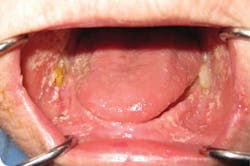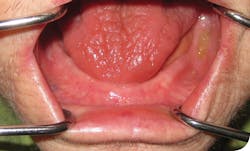8 challenges rinses will resolve in your practice
Mouth rinses are underutilized in oral care
By Kristin Goodfellow, RDH
Our patients’ many challenges range from simple ones, such as everyday care, to complex ones, such as chemotherapy or radiation. They need help, and help may be just a swish away. Professional mouth rinses are one of the most underutilized types of products in the dental field, and they are specifically designed to help our patients through some of these challenges. These aren’t your grandparents’ mouth rinses, designed and marketed just for bad breath (although they still work for this). Today’s rinses are based on science and research. Some contain ingredients that break up biofilm and eliminate bacteria, viruses, fungi, and volatile sulfur compounds, which play a detrimental role in periodontal disease and wound healing.
Let’s explore eight ways rinses can solve some of the challenges that are presented to you and your patients.
Challenge No. 1: Everyday care
We all talk to our patients about brushing and flossing, and as we all know, they are not great at it. In 2014, a Delta Dental survey found that only four out of 10 Americans floss at least once a day, while two out of 10 never floss.1 And the patients who do floss are challenged to do it correctly. As you know, flossing is not just breaking contact; flossing is making a C around each tooth and moving the floss up and down to remove the bacteria. The question is how many of your patients do that properly?
Professional rinses can help when patients don’t floss or do it incorrectly. Don’t get me wrong—I am not advocating that flossing is unnecessary, but I see so many patients who floss incorrectly or not at all (even after they’ve been educated in the chair). Also, brushing and flossing are strictly mechanical; neither is antimicrobial. This is where the right rinse could help prevent plaque buildup. Rinses can also reach areas that brushing and flossing can’t, such as the floor of the mouth, the tongue, and every other oral crevice where microbes hide and multiply.
Challenge No. 2: PLAQUE REDUCTION
Biofilm occurs when bacteria link together and create a matrix. This also allows other microbes, including viruses, fungi, and other types of bacteria, to adhere to the tooth. Many products can kill a single strain of bacteria; however, few rinses actually break up biofilm and kill the remaining bacteria. Dental plaque is a biofilm that can cause significant damage to the oral environment when not adequately removed. Rinses that break up biofilm can greatly reduce plaque, especially with compromised patients, children, and patients with braces.
Challenge No. 3: PERIODONTAL THERAPY
There are many factors that can contribute to periodontal disease. We tend to zero in on bacteria, but we must understand that studies show viruses, fungi, and volatile sulfur compounds are also factors when dealing with any type of gingivitis and periodontitis. Acknowledging these additional factors during treatment, and finding easy ways to remove them, can create ideal outcomes for patients. Plaque and calculus must also be removed so that the gingiva can properly heal. A professional rinse should kill bacteria, viruses, fungi, and eliminate volatile sulfur compounds without staining or forming calculus.
Fungal infections before rinsing.
Site after seven days of rinsing.
Challenge No. 4: BAD BREATH
I think we all know rinses can help with bad breath. However, most over-the-counter rinses simply mask the issue or focus only on killing bacteria. If you’re going to eliminate bad breath, you must kill bacteria as well as its excretions, which are volatile sulfur compounds (VSCs). VSCs are what give bad breath its odor—something you’re familiar with if you’ve encountered a patient with halitosis. Bacteria and VSCs are found throughout the mouth, especially on the tongue and under the gingiva. The right rinse can eliminate bad breath for eight to 12 hours by destroying both bacteria and VSCs.
Challenge No. 5:TISSUE MANAGEMENT AFTER SURGERY
From extractions to implant placement, the mouth is one of the toughest places to heal. The oral cavity is an ideal environment for bacteria, viruses, fungi, and VSCs. It’s also a place where it’s hard to keep wounds dry and clean. This is why professional rinses that help fight microbes and their by-products can improve healing. Also, it takes 32 to 34 days for the gingiva to heal, so it’s important to have a rinse that can be used every day and long-term.
Challenge No. 6: fungal infections
Dark and damp—that’s the mouth. This is why fungi thrive in the oral cavity. One common fungal infection, candidiasis, can affect any patient, although it is more prevalent in babies, people with immune deficiencies, and the older population, especially those with dentures. Angular cheilitis is another fungal infection that affects the corners of the mouth. Modern-day rinses that kill fungi can alleviate these infections in a matter of days.
Challenge No. 7:prerinsing
I think we all know we should be prerinsing our patients before every procedure. We should do this for three reasons: (1) to impact the environment that we will be working in, (2) to prevent cross-contamination between patients, and (3) to prevent cross-contamination between the patient and clinician.
The handpieces we use produce aerosols that contains millions of microbes, so we should try to kill as many microbes as we can before we begin working. If you prerinse, make sure to use a rinse that kills viruses along with bacteria. Many people I talk to use a rinse that kills only bacteria, but when we’re worried about cross-contamination, viruses are a real danger.
Challenge No. 8: cancer care
There are more than one and a half million new cases of cancer every year,2 and many patients go through chemotherapy or radiation treatment, possibly even a combination of the two. This wreaks havoc on the oral mucosa. Many of these patients suffer from dry mouth, burning sensations, and painful sores. Daily use of the right rinse can greatly reduce these complications and keep patients more comfortable.
In summary, to address all of these challenges, a professional rinse has to break up biofilm and eliminate bacteria, fungi, viruses, and volatile sulfur compounds. It must also be safe enough to use every day because it takes 32 to 34 days for gingiva to heal.
There are rinses on the market that address some of these challenges, but the only one that is a solution for all eight challenges is OraCare. OraCare’s active ingredients, activated chlorine dioxide and xylitol, eliminate microbes and are safe enough to use every day—plus, they do not cause staining or calculus buildup.
Whether you use OraCare or a product designed specifically to address one of the challenges above, professional rinses should play an essential role in maintaining and elevating your patients’ oral health. You can learn more about OraCare’s revolutionary health rinse at oracareproducts.com or by calling (855) 255-6722.
References
Survey finds shortcomings in oral health habits. ADA News website. https://www.ada.org/en/publications/ada-news/2014-archive/october/survey-finds-shortcomings-in-oral-health-habits. Published October 20, 2014.
Cancer statistics. National Cancer Institute website. https://www.cancer.gov/about-cancer/understanding/statistics. Updated March 22, 2017.


